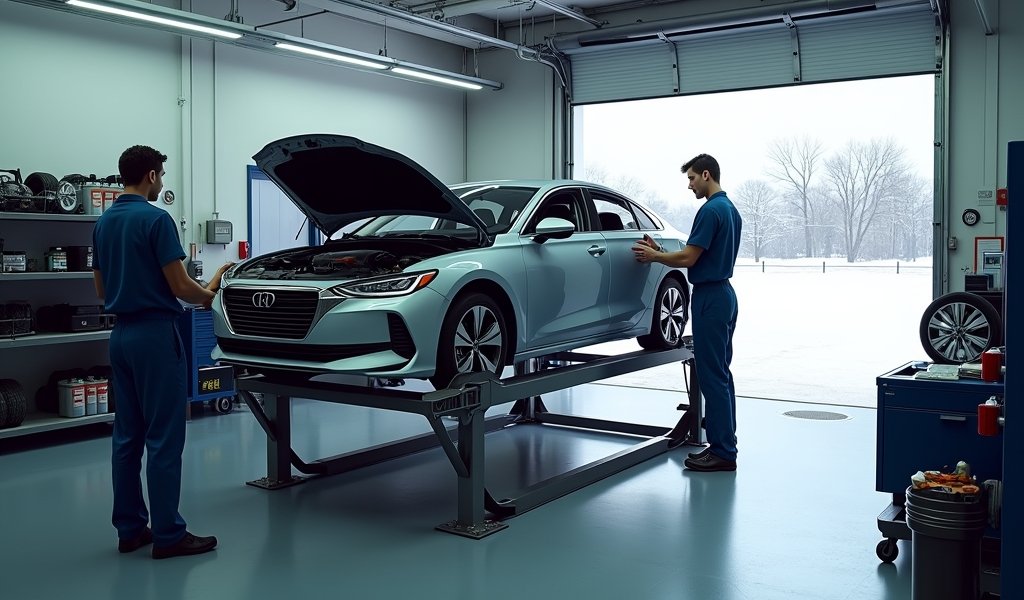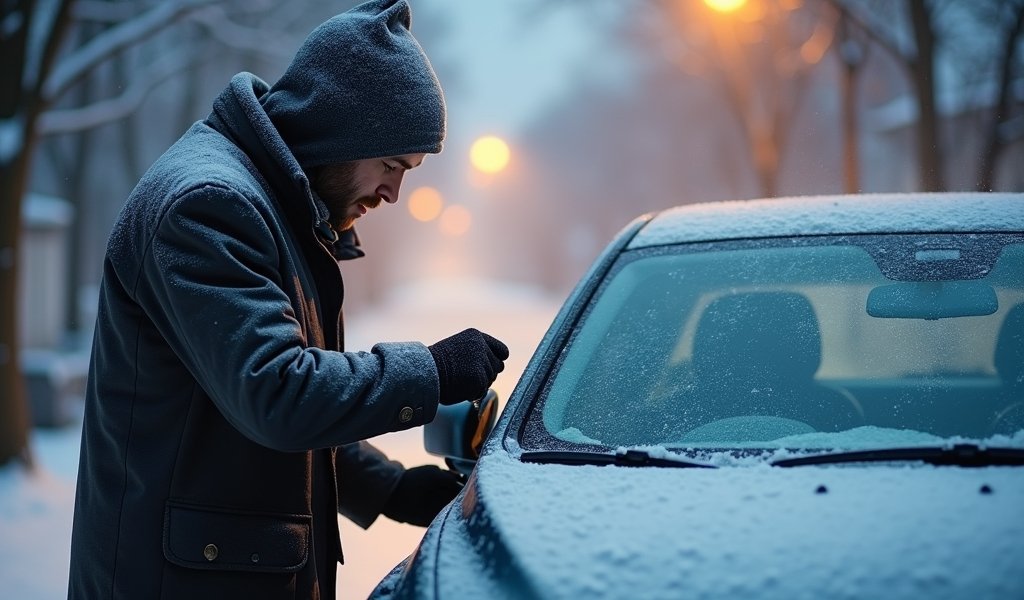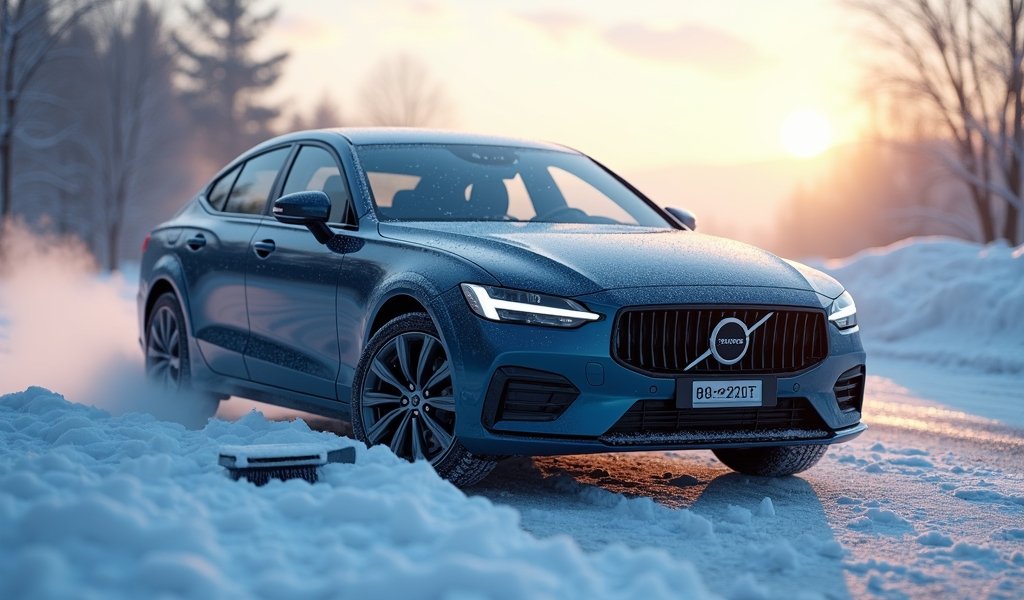Overview
This detailed guide provides essential winter car maintenance steps focusing on battery preparation, tire maintenance, fluid checks, visibility maintenance, and emergency kit assembly to ensure safety during cold weather. The article emphasizes that most winter car troubles are preventable with proper preparation, and recommends completing maintenance tasks before the first cold snap to prevent costly repairs and dangerous situations.
Table of Contents
- Why Winter Car Maintenance Matters
- Preparing Your Battery for Cold Weather
- Tire Maintenance and Preparation
- Essential Fluid Checks Before Winter
- Maintaining Proper Visibility
- Building Your Winter Emergency Kit
- Conclusion
- Frequently Asked Questions
Why Winter Car Maintenance Matters
As the temperatures start to drop and the first snowflakes begin to fall, your vehicle faces a whole new set of challenges. Having a solid winter car maintenance checklist isn’t just about preventing inconvenient breakdowns—it’s about keeping you and your loved ones safe during the most challenging driving season of the year.
I’ve been working as a mechanic for over 15 years, and let me tell you, the cars that come in with major winter problems almost always missed their preventative maintenance. The good news? Most winter car troubles are completely avoidable with some simple preparation.
Winter throws everything it has at your vehicle: freezing temperatures that thicken fluids and strain batteries, road salt that accelerates corrosion, and slick conditions that test even the best tires. A comprehensive winter car maintenance checklist helps ensure your vehicle is ready to handle whatever Mother Nature dishes out.
In this guide, I’ll walk you through the five most critical areas of winter car maintenance. We’ll go beyond the basics to help you understand not just what to do, but why each step matters. By the time you’re done reading, you’ll have a complete plan to winterize your vehicle like a professional.
Preparing Your Battery for Cold Weather
Your car’s battery works harder in winter than any other time of year. Cold temperatures reduce a battery’s capacity to provide power, while simultaneously increasing the power needed to start your car. In fact, at 0°F, a battery has only about 50% of the power it has at 80°F—a dramatic difference that explains why so many drivers find themselves stranded on cold mornings.
Start by checking your battery’s age—most batteries last between 3-5 years, though this varies based on your climate and driving habits. If your battery is approaching the end of its expected lifespan, consider replacing it before winter rather than risking a failure during a snowstorm.
Next, inspect the battery terminals for corrosion, which appears as a white, powdery substance. This corrosion restricts electrical flow, making an already-stressed battery work even harder. Cleaning the terminals is straightforward: disconnect the battery (always removing the negative terminal first), and clean the terminals with a wire brush and a simple solution of baking soda and water.
For those who aren’t comfortable working with batteries, most auto parts stores offer free battery testing. This test measures your battery’s capacity and can predict whether it’s likely to make it through the winter. Car battery care in cold weather becomes especially critical as temperatures continue to drop.
If you frequently park outdoors in extreme cold, consider a battery insulator or engine block heater. These accessories help maintain a more optimal temperature range for your battery and engine fluids, making morning starts significantly easier on your vehicle’s components.

Tire Maintenance and Preparation
Your tires are your vehicle’s only point of contact with the road, and in winter conditions, that contact becomes more critical than ever. According to NHTSA data, proper tire maintenance is one of the most important factors in winter driving safety.
First, check your tire pressure regularly throughout winter. For every 10°F drop in temperature, tires lose about 1 PSI of pressure. Underinflated tires reduce handling, decrease fuel efficiency, and wear unevenly. Your vehicle’s recommended tire pressure is typically listed on a sticker inside the driver’s door jamb—not the maximum pressure listed on the tire itself.
Next, inspect your tread depth. While the legal minimum is 2/32″, for winter driving you want at least 4/32″ of tread. The penny test works in a pinch: insert a penny into your tire tread with Lincoln’s head upside down. If you can see all of Lincoln’s head, it’s time for new tires.
Consider whether you need dedicated winter tires. If you live in an area with regular snowfall or temperatures that consistently drop below 45°F, winter tires provide significantly better traction due to their specialized rubber compounds and tread patterns. All-season tires harden in cold temperatures, while winter tires remain flexible, allowing them to grip the road better.
If you decide to stick with all-season tires, make sure they’re relatively new and in good condition. Older all-seasons with worn tread are particularly dangerous on winter roads.
Don’t forget about your spare tire! Check its pressure too—there’s nothing worse than needing your spare only to find it flat when you’re already dealing with a winter emergency.
Essential Fluid Checks Before Winter
Winter puts unique demands on your vehicle’s fluids, and ensuring they’re all at proper levels with the correct formulations can prevent costly damage and dangerous situations.
Engine oil becomes thicker in cold temperatures, making it harder for your engine to turn over. If you’re due for an oil change, consider switching to a lower viscosity oil for the winter months. For example, if you normally use 10W-30, your mechanic might recommend 5W-30 for winter. Modern synthetic oils generally perform better in extreme temperatures than conventional oils.
Antifreeze/coolant is perhaps the most obvious winter concern. This fluid prevents your engine from freezing in low temperatures while still providing cooling protection. Most vehicles use a 50/50 mix of antifreeze and water, which typically protects down to about -34°F. You can check the protection level of your coolant with an inexpensive tester from any auto parts store.
Don’t forget about your windshield washer fluid. Standard summer formulations will freeze in winter temperatures, potentially damaging your washer system and leaving you without the ability to clear your windshield. Winter-specific washer fluid contains antifreeze components and can handle temperatures well below freezing.
Brake fluid absorbs moisture over time, which can lead to decreased braking performance or even brake failure in freezing temperatures as that moisture freezes within the lines. If your brake fluid hasn’t been changed in the past two years, consider having it flushed before winter.
Transmission fluid and power steering fluid also thicken in cold weather. While these typically don’t need seasonal changes, checking their levels and condition before winter is wise. Discolored or burnt-smelling fluid should be changed regardless of the season.
Maintaining Proper Visibility
When it comes to winter driving, being able to see clearly—and being seen by others—can literally be a matter of life and death. Visibility maintenance is a crucial component of any winter car maintenance checklist.
Start with your wiper blades. Rubber deteriorates over time, and wiper blades typically need replacement every 6-12 months. Winter-specific wiper blades have a more robust rubber compound and are often enclosed in a rubber boot to prevent ice and snow buildup. The slight extra cost is well worth the improved performance during winter precipitation.
Check all exterior lights, including headlights, tail lights, brake lights, turn signals, and hazard lights. Winter’s shorter days mean you’ll be driving in darkness more often. Replace any burnt-out bulbs and consider upgrading to higher-performance bulbs if your nighttime visibility is poor. Clean your headlight lenses if they’ve become foggy or yellowed—this can dramatically improve your nighttime visibility.
Don’t overlook your defroster and heating system. These aren’t just about comfort—they’re essential safety systems that keep your windows clear of fog and ice. If your defroster isn’t working efficiently, have it checked before the first frost.
Consider applying a water-repellent treatment to your windshield and windows. Products like Rain-X create a hydrophobic surface that causes water to bead up and roll off, improving visibility during rain, sleet, and snow. Apply these treatments to all windows and your side mirrors for maximum benefit.
Finally, keep your washer fluid reservoir full throughout winter, and carry an extra gallon in your trunk. Using your washers is often the only way to clear salt spray and slush from your windshield while driving, and running out can quickly create dangerous visibility conditions.

Building Your Winter Emergency Kit
Even with perfect maintenance, winter conditions can sometimes leave you stranded. A well-stocked emergency kit can mean the difference between a minor inconvenience and a dangerous situation. The Department of Homeland Security recommends every vehicle have an emergency kit, with additional items for winter conditions.
Start with the basics: jumper cables or a portable jump starter, a flashlight with extra batteries, road flares or reflective triangles, and a first aid kit. Add a cell phone charger that works in your vehicle—your phone is your primary emergency communication device.
For winter specifically, include a snow shovel, ice scraper, and brush. Traction aids like cat litter, sand, or special traction mats can help you get unstuck from snow or ice. A tow strap is useful if another vehicle is available to help pull you out.
Pack warm emergency supplies: blankets or sleeping bags, extra warm clothing including hats, gloves, and boots, and hand warmers. If you’re stranded for an extended period, these items could prevent hypothermia.
Don’t forget about food and water. Energy bars, nuts, dried fruits, and other non-perishable snacks provide needed calories. Water can freeze, so use containers that allow for expansion or rotate your water supply regularly.
Consider adding a multi-tool, duct tape, and basic tools like screwdrivers and pliers. These can help with temporary repairs that might get you back on the road.
One often-overlooked item is a spare phone charger or portable battery pack. Many winter emergencies become dangerous simply because people can’t call for help when their phone battery dies in the cold.
Finally, keep a spare container of washer fluid and a can of de-icer spray in your trunk. These simple additions can make a huge difference when you’re caught in unexpected winter weather.
Conclusion
A thorough winter car maintenance checklist isn’t just a recommendation—it’s an essential part of responsible vehicle ownership in colder climates. By properly preparing your battery, maintaining your tires, checking all fluids, ensuring maximum visibility, and assembling a comprehensive emergency kit, you’re taking proactive steps to keep yourself and your passengers safe during challenging winter conditions.
Remember, most of these maintenance tasks aren’t particularly difficult or expensive, but they can prevent costly repairs and dangerous situations down the road. If you’re not comfortable performing any of these checks yourself, any reputable auto shop will offer winterization services.
The best time to implement your winter car maintenance checklist is before the first cold snap hits. Aim to have your vehicle winter-ready by early November in most northern regions, or at least a few weeks before temperatures typically drop below freezing in your area.
Winter driving presents unique challenges, but with a well-maintained vehicle, you can navigate the season with confidence and peace of mind. Your future self will thank you when your car starts reliably on that first frigid morning, or when your winter tires provide the traction needed to safely navigate a sudden snowstorm.
Frequently Asked Questions
When should I start my winter car maintenance?
Ideally, complete your winter car maintenance checklist in late fall, about a month before temperatures regularly drop below freezing in your area. This gives you time to address any issues before winter fully arrives.
How often should I check my tire pressure in winter?
Check your tire pressure at least once a month during winter, and after any significant temperature drops. Cold temperatures cause tire pressure to decrease, affecting handling and safety.
Do I really need winter tires if I have all-wheel drive?
Yes, even vehicles with all-wheel drive benefit substantially from winter tires. AWD helps with acceleration, but winter tires improve braking and cornering in snow and ice conditions.
What’s the most common winter car problem?
Battery failure is the most common winter car problem, as cold temperatures reduce battery capacity while increasing the power needed to start the engine. A battery that works fine in summer may fail in winter.
How long can I run my car to stay warm if I’m stranded?
If stranded, run your engine for about 10 minutes each hour to provide heat. Always ensure your exhaust pipe is clear of snow to prevent carbon monoxide from entering the vehicle.

